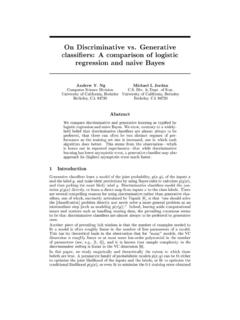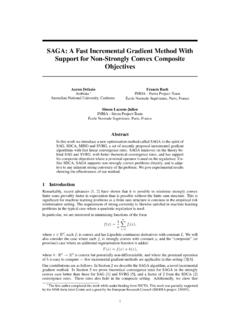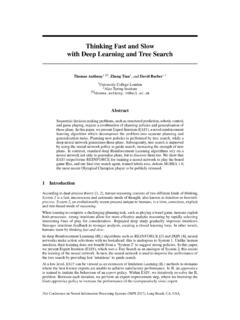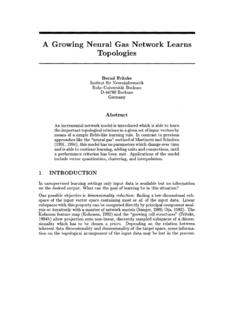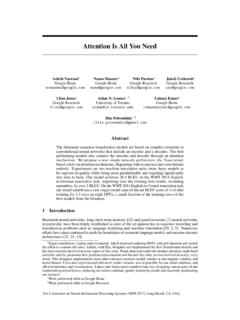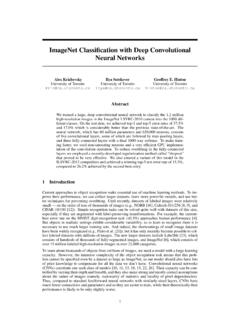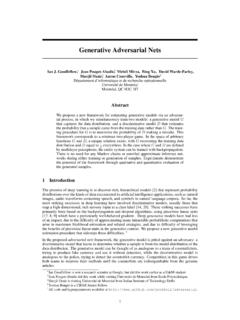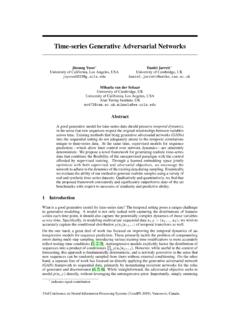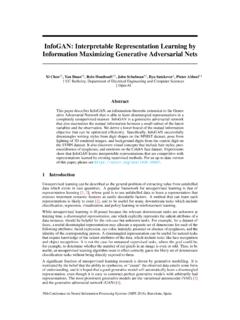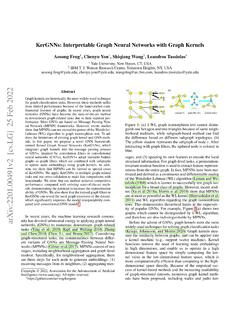Transcription of Character-level Convolutional Networks for Text Classification
1 Character-level Convolutional Networks for TextClassification Xiang ZhangJunbo ZhaoYann LeCunCourant Institute of Mathematical Sciences, New York University719 Broadway, 12th Floor, New York, NY 10003{xiang, , article offers an empirical exploration on the use of Character-level convolu-tional Networks (ConvNets) for text Classification . We constructed several large-scale datasets to show that Character-level Convolutional Networks could achievestate-of-the-art or competitive results. Comparisons are offered against traditionalmodels such as bag of words, n-grams and their TFIDF variants, and deep learningmodels such as word-based ConvNets and recurrent neural IntroductionText Classification is a classic topic for natural language processing, in which one needs to assignpredefined categories to free-text documents. The range of text Classification research goes fromdesigning the best features to choosing the best possible machine learning classifiers.}
2 To date,almost all techniques of text Classification are based on words, in which simple statistics of someordered word combinations (such as n-grams) usually perform the best [12].On the other hand, many researchers have found Convolutional Networks (ConvNets) [17] [18] areuseful in extracting information from raw signals, ranging from computer vision applications tospeech recognition and others. In particular, time-delay Networks used in the early days of deeplearning research are essentially Convolutional Networks that model sequential data [1] [31].In this article we explore treating text as a kind of raw signal at character level, and applying tem-poral (one-dimensional) ConvNets to it. For this article we only used a Classification task as a wayto exemplify ConvNets ability to understand texts. Historically we know that ConvNets usuallyrequire large-scale datasets to work, therefore we also build several of them. An extensive set ofcomparisons is offered with traditional models and other deep learning Convolutional Networks to text Classification or natural language processing at large wasexplored in literature.
3 It has been shown that ConvNets can be directly applied to distributed [6] [16]or discrete [13] embedding of words, without any knowledge on the syntactic or semantic structuresof a language. These approaches have been proven to be competitive to traditional are also related works that use Character-level features for language processing. These in-clude using Character-level n-grams with linear classifiers [15], and incorporating character-levelfeatures to ConvNets [28] [29]. In particular, these ConvNet approaches use words as a basis, inwhich Character-level features extracted at word [28] or word n-gram [29] level form a distributedrepresentation. Improvements for part-of-speech tagging and information retrieval were article is the first to apply ConvNets only on characters. We show that when trained on large-scale datasets, deep ConvNets do not require the knowledge of words, in addition to the conclusion An early version of this work entitled Text Understanding from Scratch was posted in Feb 2015 The present paper has considerably more experimental results and a rewritten previous research that ConvNets do not require the knowledge about the syntactic or semanticstructure of a language.
4 This simplification of engineering could be crucial for a single system thatcan work for different languages, since characters always constitute a necessary construct regardlessof whether segmentation into words is possible. Working on only characters also has the advantagethat abnormal character combinations such as misspellings and emoticons may be naturally Character-level Convolutional NetworksIn this section, we introduce the design of Character-level ConvNets for text Classification . The de-sign is modular, where the gradients are obtained by back-propagation [27] to perform Key ModulesThe main component is the temporal Convolutional module, which simply computes a 1-D convo-lution. Suppose we have a discrete input functiong(x) [1, l] Rand a discrete kernel functionf(x) [1, k] R. The convolutionh(y) [1,b(l k+ 1)/dc] Rbetweenf(x)andg(x)withstridedis defined ash(y) =k x=1f(x) g(y d x+c),wherec=k d+ 1is an offset constant. Just as in traditional Convolutional Networks in vision,the module is parameterized by a set of such kernel functionsfij(x) (i= 1,2.)
5 , mandj=1,2, .. , n)which we callweights, on a set of inputsgi(x)and outputshj(y). We call eachgi(orhj) input (or output)features, andm(orn) input (or output) feature size. The outputshj(y)isobtained by a sum overiof the convolutions betweengi(x)andfij(x).One key module that helped us to train deeper models is temporal max-pooling. It is the 1-D versionof the max-pooling module used in computer vision [2]. Given a discrete input functiong(x) [1, l] R, the max-pooling functionh(y) [1,b(l k+ 1)/dc] Rofg(x)is defined ash(y) =kmaxx=1g(y d x+c),wherec=k d+ 1is an offset constant. This very pooling module enabled us to train ConvNetsdeeper than 6 layers, where all others fail. The analysis by [3] might shed some light on non-linearity used in our model is the rectifier or thresholding functionh(x) = max{0, x},which makes our Convolutional layers similar to rectified linear units (ReLUs) [24]. The algorithmused is stochastic gradient descent (SGD) with a minibatch of size 128, using momentum [26] [30] initial step is halved every 3 epoches for 10 times.
6 Each epoch takes a fixednumber of random training samples uniformly sampled across classes. This number will later bedetailed for each dataset sparately. The implementation is done using Torch 7 [4]. Character quantizationOur models accept a sequence of encoded characters as input. The encoding is done by prescribingan alphabet of sizemfor the input language, and then quantize each character using 1-of-mencoding(or one-hot encoding). Then, the sequence of characters is transformed to a sequence of suchmsized vectors with fixed lengthl0. Any character exceeding lengthl0is ignored, and any charactersthat are not in the alphabet including blank characters are quantized as all-zero vectors. The characterquantization order is backward so that the latest reading on characters is always placed near the beginof the output, making it easy for fully connected layers to associate weights with the latest alphabet used in all of our models consists of 70 characters, including 26 english letters, 10digits, 33 other characters and the new line character.
7 The non-space characters are:abcdefghijklmnopqrstuvwxyz0123456789 -,;.!?: /\|_@#$% &* +-=<>()[]{}Later we also compare with models that use a different alphabet in which we distinguish betweenupper-case and lower-case Model DesignWe designed 2 ConvNets one large and one small. They are both 9 layers deep with 6 convolutionallayers and 3 fully-connected layers. Figure 1 gives an and Pool. layersFully-connectedFigure 1: Illustration of our modelThe input have number of features equal to 70 due to our character quantization method, and theinput feature length is 1014. It seems that 1014 characters could already capture most of the texts ofinterest. We also insert 2 dropout [10] modules in between the 3 fully-connected layers to have dropout probability of Table 1 lists the configurations for Convolutional layers, andtable 2 lists the configurations for fully-connected (linear) 1: Convolutional layers used in our experiments.
8 The Convolutional layers have stride 1 andpooling layers are all non-overlapping ones, so we omit the description of their FeatureSmall FeatureKernelPool11024256732102425673310 242563N/A410242563N/A510242563N/A6102425 633We initialize the weights using a Gaussian distribution. The mean and standard deviation used forinitializing the large model is(0, )and small model(0, ).Table 2: Fully-connected layers used in our experiments. The number of output units for the lastlayer is determined by the problem. For example, for a 10-class Classification problem it will be Units LargeOutput Units Small7204810248204810249 Depends on the problemFor different problems the input lengths may be different (for example in our casel0= 1014), andso are the frame lengths. From our model design, it is easy to know that given input lengthl0, theoutput frame length after the last Convolutional layer (but before any of the fully-connected layers)isl6= (l0 96)/27.
9 This number multiplied with the frame size at layer 6 will give the inputdimension the first fully-connected layer Data Augmentation using ThesaurusMany researchers have found that appropriate data augmentation techniques are useful for control-ling generalization error for deep learning models. These techniques usually work well when wecould find appropriate invariance properties that the model should possess. In terms of texts, it is notreasonable to augment the data using signal transformations as done in image or speech recognition,because the exact order of characters may form rigorous syntactic and semantic meaning. Therefore,3the best way to do data augmentation would have been using human rephrases of sentences, but thisis unrealistic and expensive due the large volume of samples in our datasets. As a result, the mostnatural choice in data augmentation for us is to replace words or phrases with their experimented data augmentation by using an English thesaurus, which is obtained from themytheascomponent used in LibreOffice1project.
10 That thesaurus in turn was obtained from Word-Net [7], where every synonym to a word or phrase is ranked by the semantic closeness to the mostfrequently seen meaning. To decide on how many words to replace, we extract all replaceable wordsfrom the given text and randomly chooserof them to be replaced. The probability of numberris determined by a geometric distribution with parameterpin whichP[r] pr. The indexsofthe synonym chosen given a word is also determined by a another geometric distribution in whichP[s] qs. This way, the probability of a synonym chosen becomes smaller when it moves distantfrom the most frequently seen meaning. We will report the results using this new data augmentationtechnique withp= comparison ModelsTo offer fair comparisons to competitive models, we conducted a series of experiments with both tra-ditional and deep learning methods. We tried our best to choose models that can provide comparableand competitive results, and the results are reported faithfully without any model Traditional MethodsWe refer to traditional methods as those that using a hand-crafted feature extractor and a linearclassifier.
